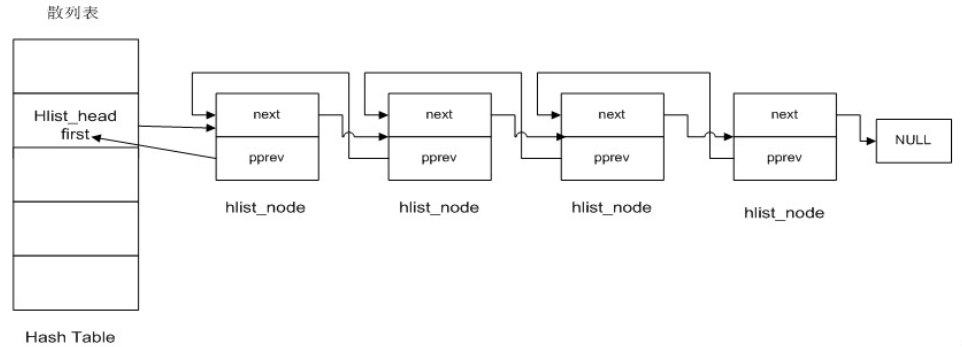一、双链表list_head
1、基本概念
linux内核提供的标准链表可用于将任何类型的数据结构彼此链接起来。
不是数据内嵌到链表中,而是把链表内嵌到数据对象中。
即:加入链表的数据结构必须包含一个类型为list_head的成员,其中包含了正向和反向指针。
struct list_head { struct list_head *next, *prev; };
由此可见,内核的链表具备双链表功能,实际上,通常它都组织成双循环链表。
该成员可以如下放置到数据结构中:
struct task_struct{ ... struct list_head run_list; ... };
链表的起点同样是list_head的实例,如果作为数据成员,则struct list_head被称作链表元素;若用于链表起点,则被称作表头。
标准双链表如下:

2、 链表操作函数(linux/list.h)
(1)声明和初始化
通常用LIST_HEAD(list_name)宏来声明并初始化:
#define LIST_HEAD_INIT(name) { &(name), &(name) } #define LIST_HEAD(name) struct list_head name = LIST_HEAD_INIT(name)
它的next、prev指针都初始化为指向自己,这样就有了一个空链表。
除了用LIST_HEAD()宏在声明的时候初始化一个链表以外,Linux还提供了一个INIT_LIST_HEAD宏用于运行时初始化链表:
static inline void INIT_LIST_HEAD(struct list_head *list) { list->next = list; list->prev = list; }
(2)插入
对链表的插入操作有两种:
在表头插入:
static inline void __list_add(struct list_head *new, struct list_head *prev, struct list_head *next) {//在两个连续的链表项之间添加一个新项,适用于已知前后两个链表项的情况 next->prev = new; new->next = next; new->prev = prev; prev->next = new; } /** * list_add - add a new entry * @new: new entry to be added * @head: list head to add it after * * Insert a new entry after the specified head. * This is good for implementing stacks. */ static inline void list_add(struct list_head *new, struct list_head *head) {//添加节点到head后。若把最后一个节点当head,则实现了一个栈 __list_add(new, head, head->next); }
在表尾插入:
/** * list_add_tail - add a new entry * @new: new entry to be added * @head: list head to add it before * * Insert a new entry before the specified head. * This is useful for implementing queues. */ static inline void list_add_tail(struct list_head *new, struct list_head *head) {//添加到head前,即尾部。把第一个元素当head,则实现了一个队列 __list_add(new, head->prev, head); }
(3)删除
/* * Delete a list entry by making the prev/next entries * point to each other. * * This is only for internal list manipulation where we know * the prev/next entries already! */ static inline void __list_del(struct list_head * prev, struct list_head * next) {//链表项指向彼此 next->prev = prev; prev->next = next; } /** * list_del - deletes entry from list. * @entry: the element to delete from the list. * Note: list_empty() on entry does not return true after this, the entry is * in an undefined state. */ static inline void __list_del_entry(struct list_head *entry) { __list_del(entry->prev, entry->next); } static inline void list_del(struct list_head *entry) {//删除节点(仅将其从链表中移走,而不会释放entry或释放包含entry的数据结构 __list_del(entry->prev, entry->next); entry->next = LIST_POISON1;//用于调试,以便在内存中检测已经删除的链表元素 entry->prev = LIST_POISON2; }
(4)合并
static inline void __list_splice(const struct list_head *list, struct list_head *prev, struct list_head *next) { struct list_head *first = list->next; struct list_head *last = list->prev; first->prev = prev; prev->next = first; last->next = next; next->prev = last; } /** * list_splice - join two lists, this is designed for stacks * @list: the new list to add. * @head: the place to add it in the first list. */ static inline void list_splice(const struct list_head *list, struct list_head *head) {//list指向链表插入到指定链表head后 if (!list_empty(list)) __list_splice(list, head, head->next); }
(5)遍历
/** * list_for_each_entry - iterate over list of given type * @pos: the type * to use as a loop cursor. * @head: the head for your list. * @member: the name of the list_struct within the struct. pos是一个指向包含list_head节点对象的指针,可看做list_entry的返回值 head是一个指向头结点的指针,即开始遍历位置 member是实际数据结构内部list_head实例的名称 */ #define list_for_each_entry(pos, head, member) for (pos = list_entry((head)->next, typeof(*pos), member); &pos->member != (head); pos = list_entry(pos->member.next, typeof(*pos), member))
a.举例
遍历与一个超级块(struct super_block)相关联的所有文件(通过struct file表示),这些file实例包含在一个双链表中,表头位于超级块实例中:
struct super_block *sb = get_some_sb(); struct file *f; list_for_each_entry(f, &sb->s_files, f_list){ /*用于处理f中成员的代码*/ }
super_block->s_files用作链表起始点,其中存储了file类型的链表项,file->f_list用作链表元素,用于建立各链表项之间的关联:
struct file{ ... struct list_head f_list; ... }
struct super_block { ... struct list_head s_files; ... }
b.讲解
链表元素遍历分为两个阶段:查找下一项list_head实例。这与链表中保存的具体数据结构无关。内核通过反引用当前链表元素的next成员,就可以找到下一个链表元素位置;查找链表元素的容器对象实例(链表的实现基于容器机制,用于将对象嵌入到其他对象中,如果结构A包含一个子结构B,则A称为B的一个容器)。其中包含了有用数据,通过list_entry宏查找。
/** * list_entry - get the struct for this entry * @ptr: the &struct list_head pointer. * @type: the type of the struct this is embedded in. * @member: the name of the list_struct within the struct. ptr指向链表元素指针 type制定了容器对象类型(上例struct file) member定义了容器的哪个元素表示当前链表的链表元素(上例是f_list,因为链表元素由file->f_list表示) */ #define list_entry(ptr, type, member) container_of(ptr, type, member)
其中:
#define offsetof(TYPE, MEMBER) ((size_t) &((TYPE *)0)->MEMBER) /** * container_of - cast a member of a structure out to the containing structure * @ptr: the pointer to the member. * @type: the type of the container struct this is embedded in. * @member: the name of the member within the struct. * 从结构成员来获得包含成员的结构类型 ptr指向成员数据的指针 type所嵌入到容器结构的类型 member成员在结构内的名称 */ #define container_of(ptr, type, member) ({ const typeof( ((type *)0)->member ) *__mptr = (ptr); (type *)( (char *)__mptr - offsetof(type,member) );})
在本例中,将offset宏展开:
(size_t) &((struct file *)0)->f_list
通过空指针将0转换为一个指向struct file的指针,然后执行的->和&获得的地址,计算出了f_list成员相对于struct file实例的偏移量。
将上例展开:
const (struct list_head*) __mptr = (ptr);
(struct file *)((char *)__mptr - offset);
ptr指向容器元素中的list_head实例。内核首先创建一个指针__mptr,其值与ptr相同,指向所要求的目标数据类型struct list_head。接下来,使用此前计算的偏移量来移动__mptr,使之不再指向链表元素,而是指向容器对象实例。为确保指针运算是按字节执行,先将__mptr转换为char *指针。但在计算完成后的赋值操作中,又转换回原来的数据类型。
二、散列表hlist_head
1、基本定义
散列表(Hash table,也叫哈希表),是根据关键码值(Key value)而直接进行访问的数据结构。也就是说,它通过把关键码值映射到表中一个位置来访问记录,以加快查找的速度。这个映射函数叫做散列函数,存放记录的数组叫做散列表。
struct hlist_head{ struct hlist_node *first; } struct hlist_node { struct hlist_node *next,**pprev; }

(1)hlist_head表示哈希表的头结点。哈希表中每一个entry(list_entry)所对应的都是一个链表(hlist)。hlist_head结构体只有一个域,即first,first指针指向该hlist链表的第一个结点。
(2)hlist_node结构体有两个域,next和pprev:
a.next指向下个hlist_node结点,倘若该结点是链表的最后一个节点,next则指向NULL
b.pprev是一个二级指针,它指向前一个节点的next指针。
2、解说
(1)Linux 中的hlist(哈希表)和list是不相同的,在list中每个结点都是一样的,不管头结点还是其它结点,使用同一个结构体表示,但是在hlist中,头结点使用的是struct hlist_head来表示的,而对于其它结点使用的是strcuct hlist_node这个数据结构来表示的。还有list是双向循环链表,而hlist不是双向循环链表,因为hlist头结点中没有prev变量。为什么要这样设计呢?
--因为哈希散列表在内核中使用的非常多,这样的头节点定义能使包含hlist_head的结构稍微变小一点,节省一半的内存空间。
(2)hlist的结点有两个指针,但是pprev是指针的指针,它指向的是前一个结点的next指针,为什么要采用pprev,而不采用一级指针?
--由于hlist不是一个完整的循环链表,在list中,表头和结点是同一个数据结构,直接用prev是ok的。在hlist中,表头中没有prev,只有一个first。
1>为了能统一地修改表头的first指针,即表头的first指针必须修改指向新插入的结点,hlist就设计了pprev。hlist结点的pprev不再是指向前一个结点的指针,而是指向前一个节点(可能是表头)中的next(对于表头则是first)指针,从而在表头插入的操作中可以通过一致的node->pprev访问和修改前结点的next(或first)指针。
2>还解决了数据结构不一致,hlist_node巧妙的将pprev指向上一个节点的next指针的地址,由于hlist_head和hlist_node指向的下一个节点的指针类型相同,就解决了通用性。
(3)内核采用的解决哈希冲突的方法是:拉链法
--拉链法解决冲突的做法是:将所有关键字为同义词的结点链接在同一个链表中。若选定的散列表长度为m,则可将散列表定义为一个由m个头指针(struct hlist_head name)组成的指针数组T[0..m-1]。凡是散列地址为i的结点,均插入到以T[i]为头指针的链表中。T中各分量的初值均应为空指针。在拉链法中,装填因子α(装填的元素个数/数组长度)可以大于 1,但一般均取α≤1。当然,用拉链法解决hash冲突也是有缺点的,指针需要额外的空间。
(红黑树、基数树这种用到再说吧....)
参考:
《深入linux内核架构》